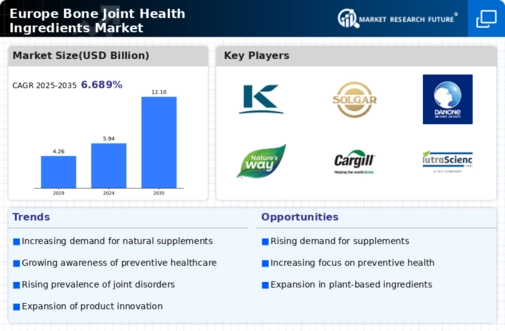The competitive dynamics within the bone joint-health-ingredients market are characterized by a blend of innovation, strategic partnerships, and a focus on sustainability. Key growth drivers include an aging population, increasing awareness of joint health, and a rising demand for natural ingredients. Major players such as Nestle (CH), Abbott Laboratories (US), and BASF (DE) are actively shaping the landscape through their distinct operational focuses. Nestle (CH) emphasizes innovation in product formulations, particularly in functional foods that support joint health, while Abbott Laboratories (US) leverages its extensive research capabilities to develop targeted supplements. BASF (DE), on the other hand, is concentrating on sustainable sourcing and production methods, which aligns with the growing consumer preference for environmentally friendly products. Collectively, these strategies foster a competitive environment that prioritizes quality and efficacy over mere price competition.
Key business tactics employed by these companies include localizing manufacturing and optimizing supply chains to enhance efficiency and responsiveness to market demands. The market structure appears moderately fragmented, with several players vying for market share, yet the influence of key companies remains substantial. This competitive structure allows for a diverse range of products, catering to various consumer preferences and health needs, while also fostering innovation through competition.
In October 2025, Nestle (CH) announced a partnership with a leading biotechnology firm to develop a new line of joint health supplements utilizing advanced fermentation technology. This strategic move is likely to enhance Nestle's product offerings and position it as a leader in the functional food segment, appealing to health-conscious consumers seeking scientifically backed solutions for joint health. The collaboration underscores the importance of innovation in maintaining competitive advantage in a rapidly evolving market.
In September 2025, Abbott Laboratories (US) launched a new clinical study aimed at evaluating the efficacy of its latest joint health supplement, which incorporates a unique blend of collagen and hyaluronic acid. This initiative not only reinforces Abbott's commitment to research-driven product development but also serves to build consumer trust through transparency and scientific validation. The results of this study could potentially influence future product formulations and marketing strategies, further solidifying Abbott's position in the market.
In August 2025, BASF (DE) unveiled its new sustainability initiative focused on reducing carbon emissions in the production of its joint health ingredients. This initiative is indicative of a broader trend towards sustainability within the industry, as consumers increasingly favor brands that demonstrate environmental responsibility. By prioritizing sustainable practices, BASF is likely to enhance its brand reputation and appeal to a growing segment of eco-conscious consumers.
As of November 2025, current trends in the bone joint-health-ingredients market are increasingly defined by digitalization, sustainability, and the integration of artificial intelligence in product development and marketing strategies. Strategic alliances are becoming more prevalent, as companies recognize the value of collaboration in driving innovation and expanding market reach. Looking ahead, competitive differentiation is expected to evolve, with a notable shift from price-based competition to a focus on innovation, technology, and supply chain reliability. This transition may ultimately reshape consumer expectations and industry standards, emphasizing the importance of quality and efficacy in product offerings.


















Leave a Comment